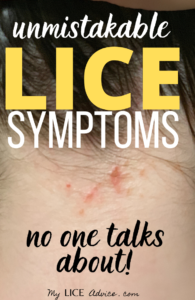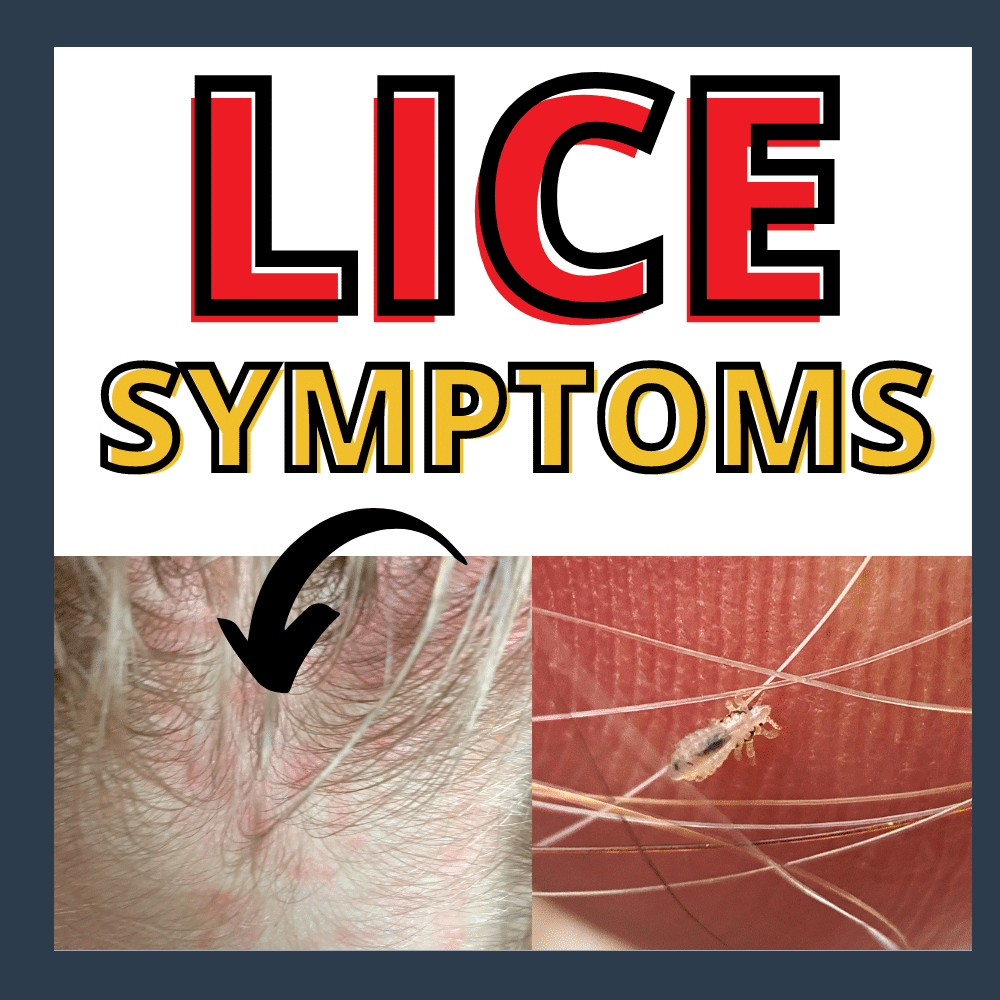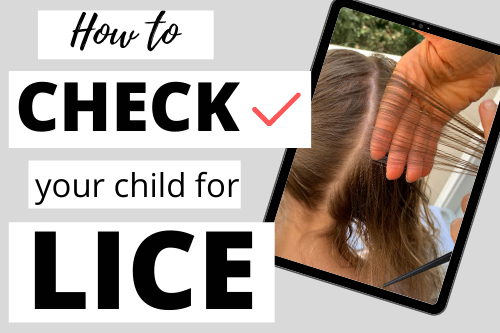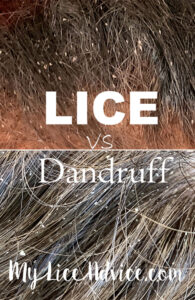17 Lice Symptoms with Pictures:
Signs That You Have Head Lice
17 Lice Symptoms with Pictures:
(Signs That You Have Head Lice)
From a Lice Expert:
There are 17 common head lice symptoms. This article is loaded with pictures so you can discover whether it's lice or not.
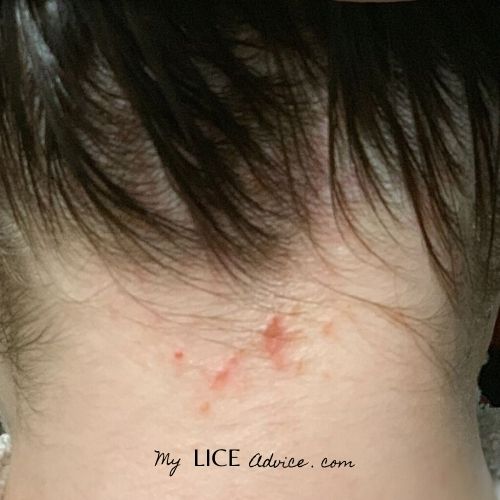
The Top Signs of Head Lice Video Tutorial
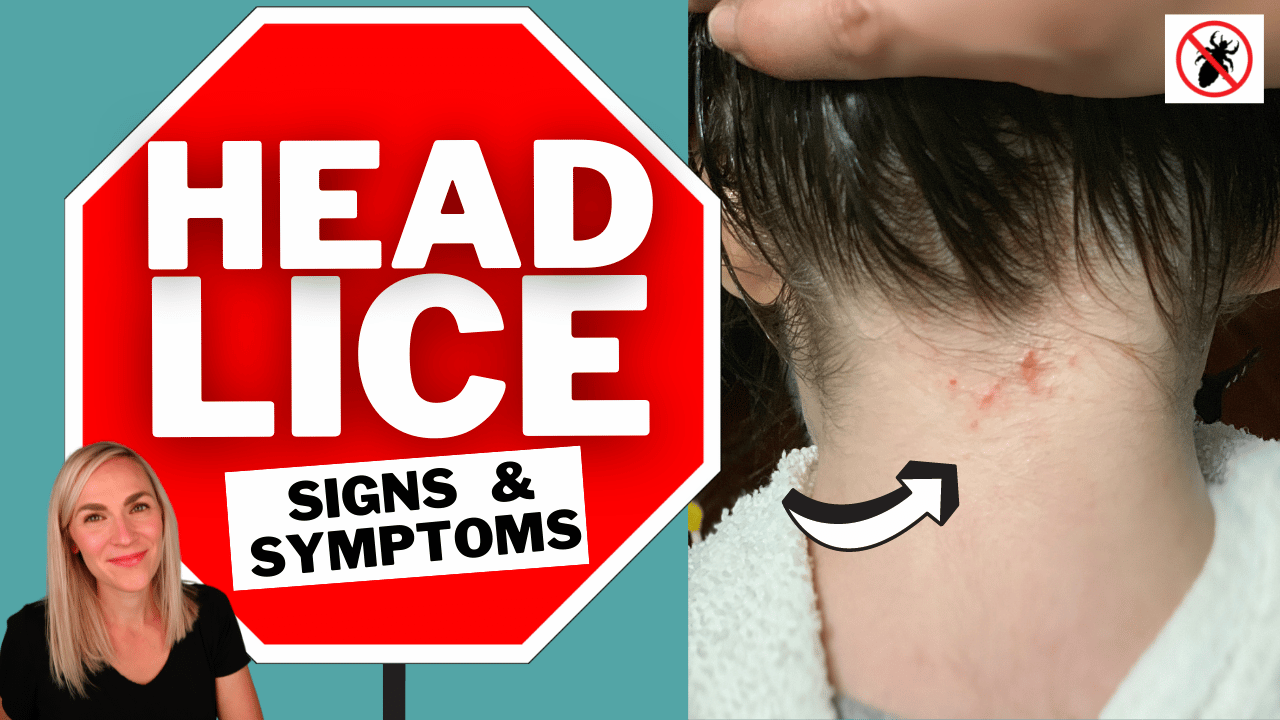
Let me introduce myself...
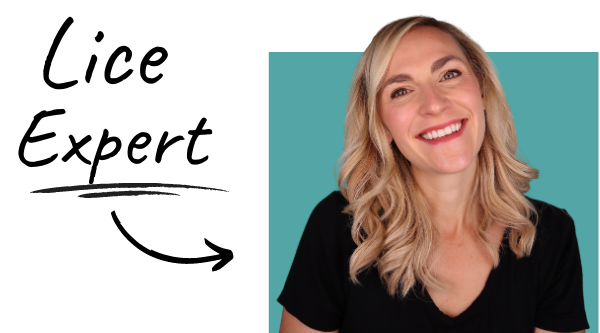
Hi there! I'm a lice expert, lice coach, Registered Nurse, and the creator of My Lice Advice. I help people with lice every day in my lice treatment center, in school districts, and in government work. But the thing I love the most is empowering parents to get rid of head lice in ONE DAY at home!
You can eliminate lice in one day using the same proven professional technique I use in my lice center on your child. Follow along with the Step-by-Step Video System, and when you're done with the videos you're done with lice. PERMANENTLY!
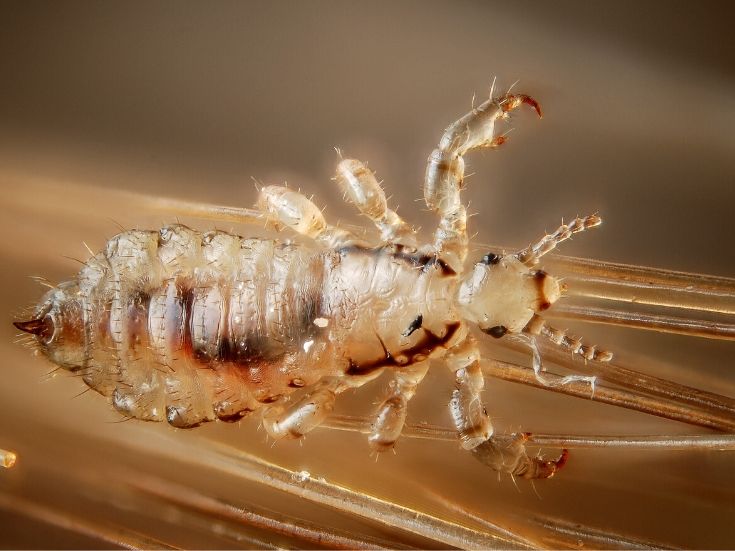
There are 3 Main Types of Lice
There are three main types of human lice: body lice, pubic lice, and (the most common) HEAD LICE.
- Body lice (the least common type of lice) is associated with poor hygiene and can be easily treated by bathing and changing into clean clothing. It’s typically only seen in homeless or refugee camps. If you are someone who bathes regularly, you certainly don’t have body lice.
- Pubic lice, also known as “crabs,” is…well...in pubic hair. However, pubic lice can make their way into eyebrows, beards, or chest hair. Pubic lice is similar to an STD and is generally only passed during intercourse.
- Head Lice (that's what this article is about, keep reading)
HEAD LICE
Head lice stick solely to the hair of the head and near the head. Head lice is NOT associated with poor hygiene. On the contrary, it does not matter how much you wash your hair, head lice are completely unphased.
Head lice are tiny parasites that live, breed, and feed exclusively on the human scalp. They are extremely contagious among close family and friends, especially among children.
Head lice are not dangerous and do not spread diseases, but they can cause very uncomfortable symptoms, all of which will be discussed here.
Why Is It So Hard to Get Rid of Lice?
Now that you know what you're looking for I want to talk briefly about your biggest worry (that your child actually has lice) and the question I get asked by parents around the world that have been battling lice….
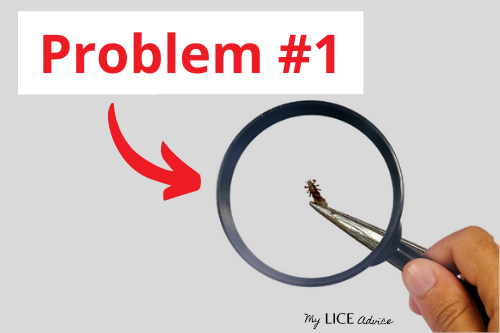
Parents around the world are all asking me the same question…. "Why is it so much harder to get rid of lice now?"
Lice have become immune to everything that used to work in the past. Perhaps you remember your mom using a typical lice treatment or mayonnaise and that doing the trick. The new strain of head lice is no longer killed by those treatments, that’s why lice today are termed by people, “super lice,” because they are immune to those treatments.
I’ve cured thousands of people of lice in my lice center and let me tell you, I don't do it with over-the-counter lice treatments.
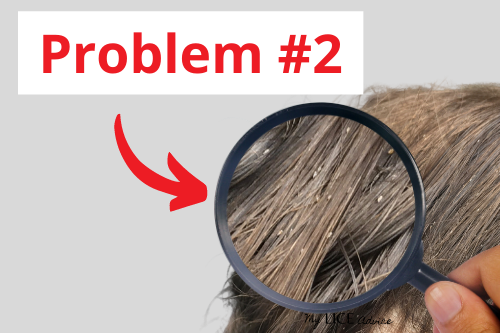
Most people struggle with lice because they focus all of their attention on killing lice bugs and not enough attention on GETTING RID OF LICE!
If you want to get rid of lice you have to address all 3 of the problems of lice:
- Lice Bugs
- Lice Eggs
- Getting Lice Back
The best way to get rid of lice is to tackle all 3 of these problems at the same time, which is what I teach in my step-by-step video system.
So, if you discover your child HAS lice, don't panic. Just head over to the video system. Follow along with the videos and you'll be done with lice by the end of the day.
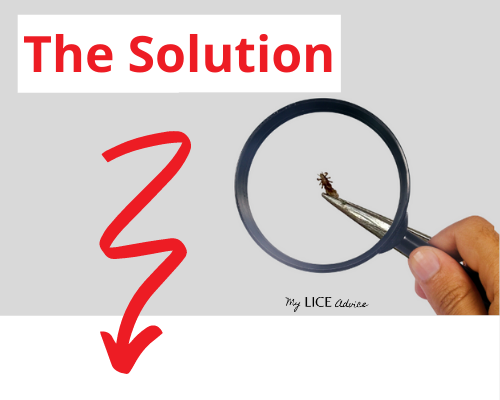
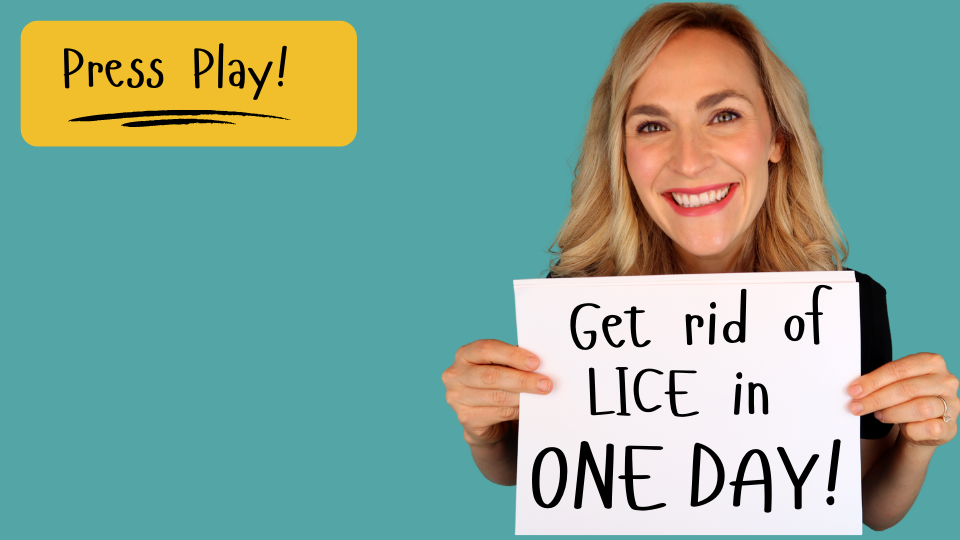
Signs and Symptoms of Head Lice
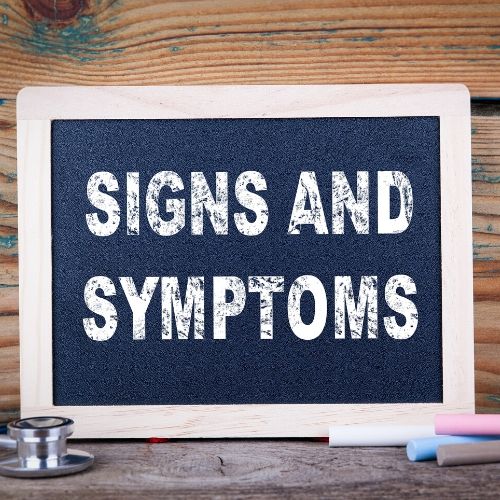
Symptom #1 – Bugs in the Hair
Lice are small parasitic bugs. They can be almost invisible as babies (also called “nymphs”) and grow to the size of a sesame seed as adults. Their food source is human blood, which they get from feeding off the human scalp.
Lice are experts at survival in hair under most conditions; they can’t be washed out, brushed out, or blow-dried out. They almost never leave the head unless travelling to another head.
Head lice are the only bugs that live in human hair. If you find multiple bugs in your child’s hair and wonder if it is head lice, the short answer is yes, it is.
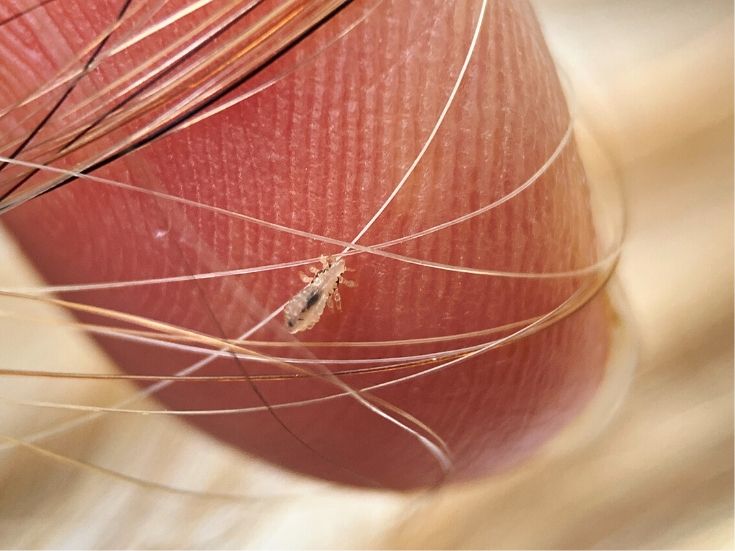
This is what head lice looks like. This photo compares the size with that of a woman’s pointer finger:
- 6 legs attached to upper ⅓ of body, not on the large abdomen
- No wings
- Tan to brown (often translucent) body, darker body as they get older and after they die
- Black stomach/intestines visible through translucent body (larger after feeding)
- Antennae
- Tapered/claw-like legs
If you find a bug like this in the hair, then your search for answers is over. Yes, you are dealing with lice.
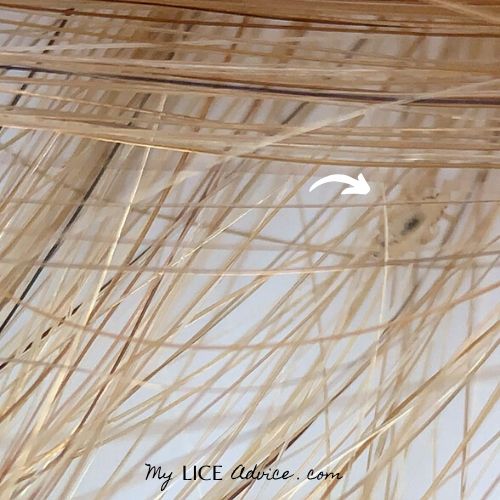
If you don’t see bugs in the hair, DO NOT automatically assume you do not have lice. It is rare to see lice crawling around in the hair during the early stages of a lice infestation. Lice are experts at camouflaging in hair. For instance, check out at how well that same bug blends in with hair in this picture.
Symptom #2 – Lice Eggs
Lice Eggs = Nits
Lice eggs, also called “nits,” are one of the first signs of head lice. Nits can be found long before any lice are usually spotted in the hair and before your head starts itching.
Nits are often mistaken for dandruff or dirt in the hair because they are small and their shiny appearance can make them look white. There are 7 main differences between lice and dandruff. Some of the significant differences are that nits stick to your hair strand, they;re teardrop-shaped, and they vary in color from translucent to almost black.
Looking for Lice Eggs/Nits
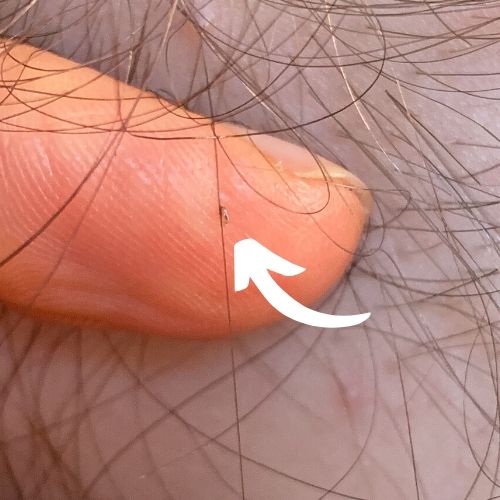
Unlike adult lice, nits do not move around or hide. These eggs are glued onto the hair strand so they will not fall off.
This makes finding lice eggs much easier than finding grown lice. Because nits in your child’s hair is one of the first signs of a lice infestation, finding them at this stage can help you eliminate lice entirely when there are only a few adult lice bugs.
Hot Spots
The best places to look for lice eggs are in the “hot spots” of the head: behind the ears, the nape of the neck and the crown of the head.
Lice eggs are about the size of a poppyseed. They can be translucent to almost black in color depending on how close they are to hatching.
One of the defining traits of lice eggs is that they will not flick, blow, or brush off. They are glued to the hair strand about ¼ inch away from the scalp.
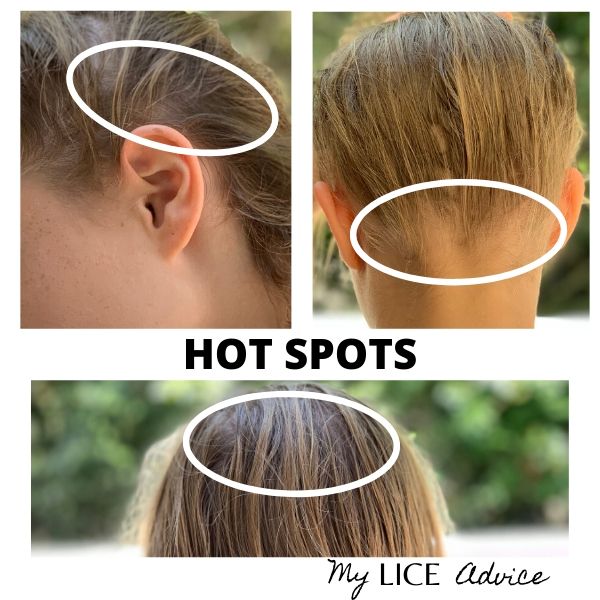
How to Check for Lice Eggs
Checking for lice eggs in the “hot spots” of the head small section by small section is the best way to determine whether someone has lice in the early stages. Here’s a link to a full tutorial on how to check for head lice.
Symptom #3 – Itching (Some Do, Some Don’t)
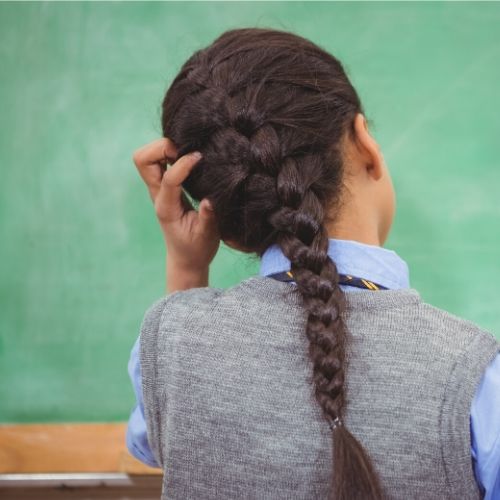
Itchy Scalp
Most people do not noticeably itch until they have had lice for a full month!
Talking about lice makes most heads itch. (You’re probably itching your head at this very moment.) However, when I say “lice causes an itchy scalp,” I’m not talking about a little scratch here and there. After a full month of having head lice, most people’s heads begin driving them crazy. The itch is a deep internal nagging that you just can’t seem to scratch enough to satisfy.
Many people assume the itchiness is caused by lice moving around on the head, but it is actually the result of an allergic reaction to lice saliva, which is why it takes most people a full month to begin itching.
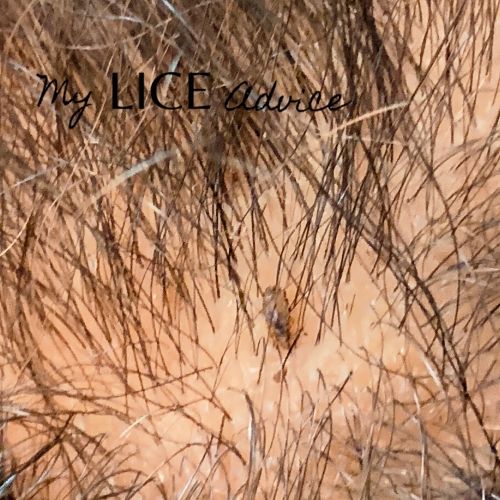
Each time lice feed on your blood, a small amount of their saliva shoots into your scalp. A little bit of this saliva goes unnoticed, but after a month of this repeated feeding, your head develops an allergic response to the lice bites and saliva.
The scalp will then begin to itch constantly, even when lice are not feeding. Just like a mosquito bite itches more after the mosquito has left, even if the lice are removed, the scalp can still itch for several days until the allergic reaction goes away.
Lots of People Don't Itch At All
Some people are EXTREMELY allergic to lice, and their head goes into hyper-itch as soon as a single bug feeds on their head. These people usually figure out that they have lice right away, before it turns into an infestation.
Unbelievably, though, many people’s heads do not itch AT ALL! They can be fully infested with head lice for months and not have ANY allergic reaction. These people usually don’t discover lice until they have spread it to many people and they have a relatively severe infestation.
Itchy Neck and Around the Ears
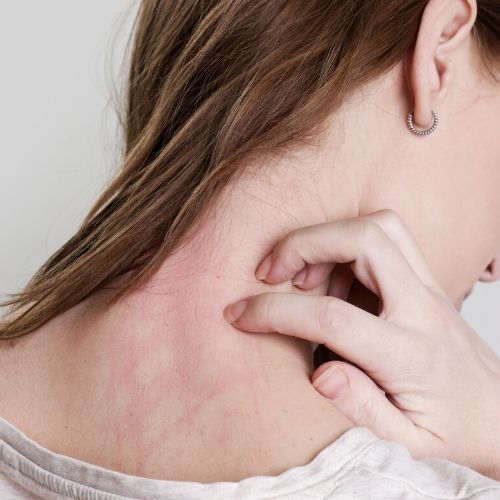
Itching Around the Ears
Similar to the deep “itch you just can’t scratch” feeling on the scalp, many people have the same feeling in the hairline near their ears and behind their ears. This makes sense when you consider that behind the ear is one of the “hot spots” where lice prefer to lay their eggs.
Itchy Neck
The neck is another one of those “hot spots” where lice like to lay their eggs. Itching right at the hairline of the neck and the neck itself is very common.
Symptom #4 – Rash or "Lice Bites"
Another sign of lice caused by an allergic reaction to lice saliva is a rash or red bumps. For many people, this sign can show up even before the itching begins. Many people term this "lice bites." In reality, these aren't actually lice bites, it's just another allergic reaction to lice saliva.
Lice Neck Rash

Most commonly, a blotchy, painless (or itchy) rash develops at the nape of the neck in the hair. The rash sometimes spreads to below the hairline at the nape of the neck.
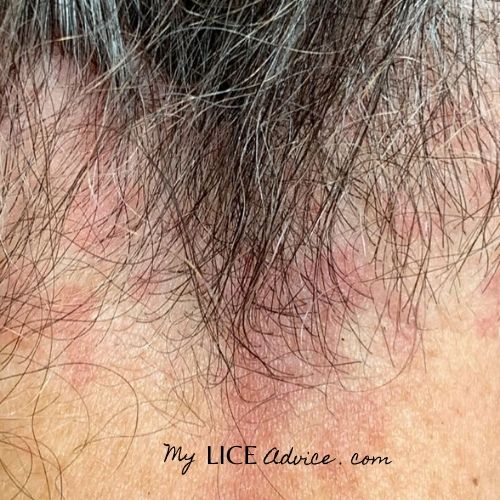
Other people with more severe reactions will have a blotchy red rash starting in their hairline and reaching to the end of their neck or have several red bumps on their neck. Severe neck rashes like this usually itch quite a bit.
Head Lice Rash Around the Ears
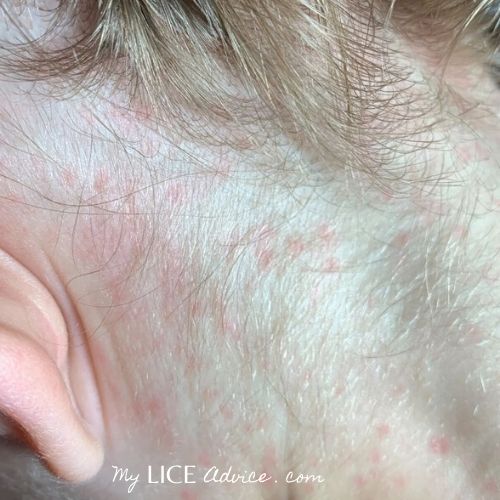
The second most common place is behind the ears. This rash is usually either completely red, blotchy red, or has a small lice bite-type appearance. It may itch, but is usually not painful.
Lice Rash on the Scalp
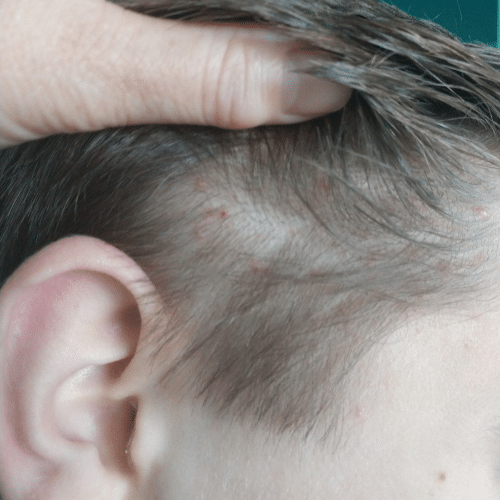
Some develop a rash on their entire scalp. It can either look like the picture above with several scab or pimple-like raised areas or it can be a patch rash all of the scalp. These rashes may or may not itch.
Again, some people will call these "lice bites" which isn't actually what you're seeing. In reality it's just your body's reaction to lice saliva over time, the bumps don't coordinate with the areas that lice have fed.
Lice reactions are unique for each person...some people itch, some people get rashes like this and some people have none of the above.
Symptom #5 – Ticking or “Something is in My Hair”
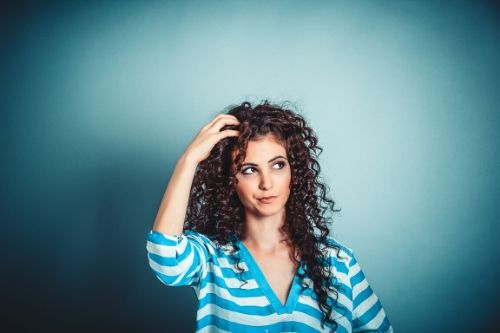
It is very rare for most people to actually “feel” lice crawling on their head, although it is VERY common to believe that you “feel” lice crawling on your head (even if you don’t have lice!). This is just our mind playing tricks on us through the power of suggestion.
However, there are some individuals with very sensitive heads who can actually feel lice moving on their hair. (These are usually the same folks that can reach into their hair and just pull out a bug.) People with highly sensitive scalps like this usually know that they have lice right away and it doesn’t progress very far.
Symptom #6 – Itching While Sleeping
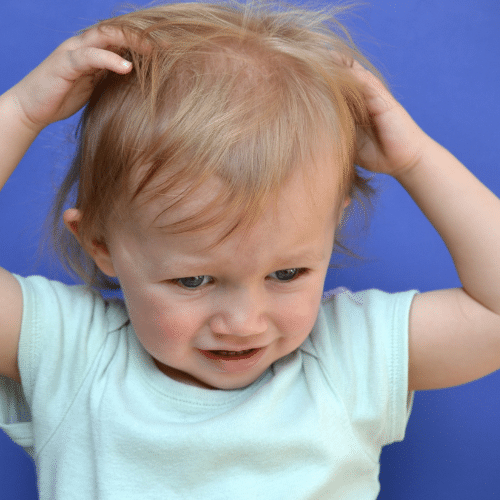
Parents, if you see your child scratching her head frequently while they’re sleeping, it is a tell tale sign of head lice. Lice are nocturnal, which means that they do most of their moving and feeding at night. Intense head itching at night usually means head lice.
Symptom #7 – Restless at Night, Sleepy During the Day
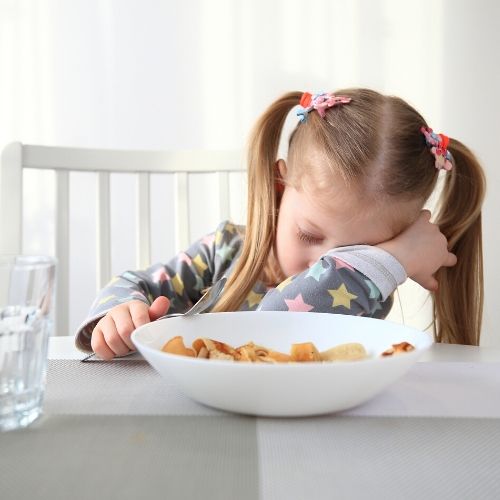
Lice are nocturnal, which means that they do most of their moving and feeding at night. This movement and feeding usually increases feelings of discomfort and itching in the night hours. It is not uncommon for someone with lice to “sleep all night” but wake up completely exhausted because they have been scratching their head all night, which in turn leads to sleepiness and fatigue during the day.
Symptom #8 – Increased Dandruff
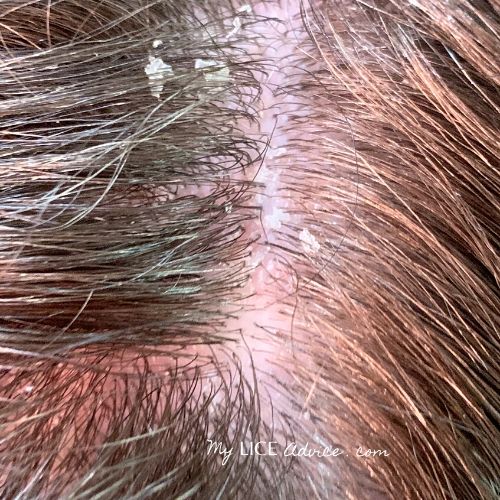
While many people believe that they are seeing dandruff when they are actually seeing lice eggs, there are also several people that have an increase in dandruff when they have head lice. This is part of their bodies’ “allergic reaction” trying to fight off lice. The dandruff usually comes off in large chunks. This skin condition can be normal for some people, but a sudden onset of extreme dandruff like this can be a response to head lice.
If you want to learn how to tell the difference between lice and dandruff check out my article Lice vs Dandruff – 7 Key Differences.
Symptom #9 – Tickling Sensation on the Whole Ear
Some people’s first sign of head lice is that their ears feel strange. I have heard it described by people as “tingling ears,” “itchy ears,” or “like someone is tickling my ears.” The sensation is unique; their whole ear feels strange, inside and out. I have had several clients in my lice center with this reaction to head lice. Every time they get head lice they always have the same strange tickly/tingling/itching of their whole ear.
Some mistakenly believe this tickling inside the ear means that head lice are actually inside their ear! But head lice are not in your ear. This tickling sensation is just your bodies response to the lice saliva on your head.
Symptom #10 – Bumps on Scalp
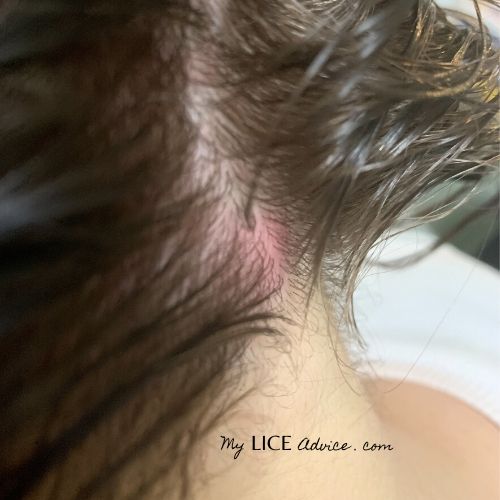
Some people develop several “cyst-like” bumps on their scalp, similar to acne. It is unclear whether these bumps are actually swollen areas where lice have fed (lice bites) or if it is an overall allergic reaction to lice saliva.
Later Signs of Head Lice
The following signs and symptoms are more typical of those with severe infestations that have had lice for several months.
Symptom #11 – Sores and Scabs on the Scalp
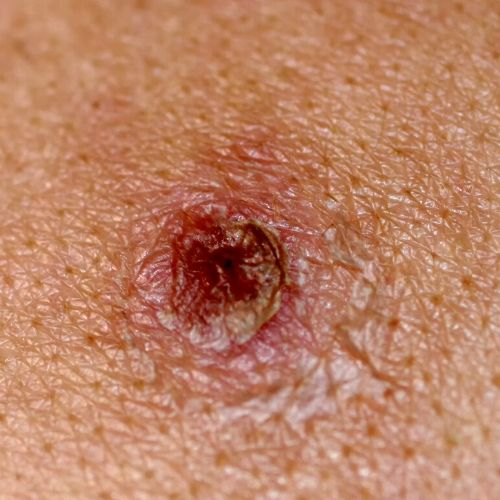
Sores and scabs on the scalp are usually the consequence of severe scratching where fingernails dig into the scalp so intensely that the outer layer of skin comes off. In rare cases, bacteria can enter into these scabs and a bacterial infection on the scalp can ensue.
Symptom #12 – Weeping of the Scalp
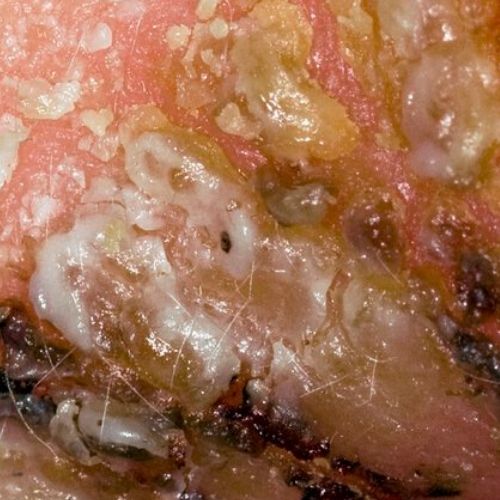
Weeping of a clear or light pink fluid (“serous fluid”) is usually only in severe cases of head lice. This serous fluid is the scalp’s reaction to trying to fight off bacteria and heal the scalp. Unfortunately, when the clear fluid dries in the hair, it becomes glued together and matted, making head lice more difficult to address.
Symptom #13 – Irritability
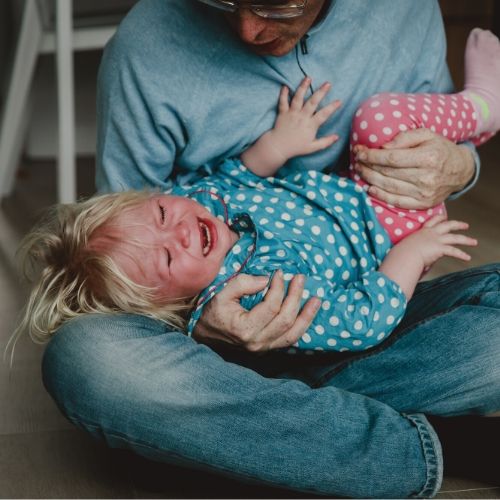
If your child is especially irritable, it can also be a sign of head lice. This increased irritability is usually a result of fitful sleeping due to itchy scalp and general discomfort from head lice.
Symptom #14 – Rash or red bumps on the shoulders or upper back
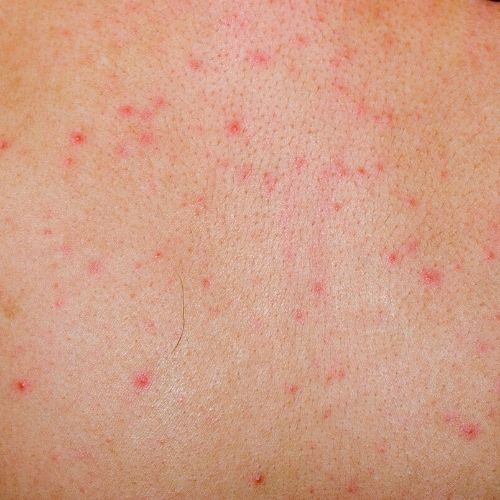
Most people’s lice rashes do not extend past the neck, but for those with severe allergic reactions to lice saliva, the rash can extend to the shoulders and upper back. This does not mean that lice are feeding on the shoulders or back; it’s just that the allergic, histamine response is making its way down the body.
Symptom #15 – Fatigue
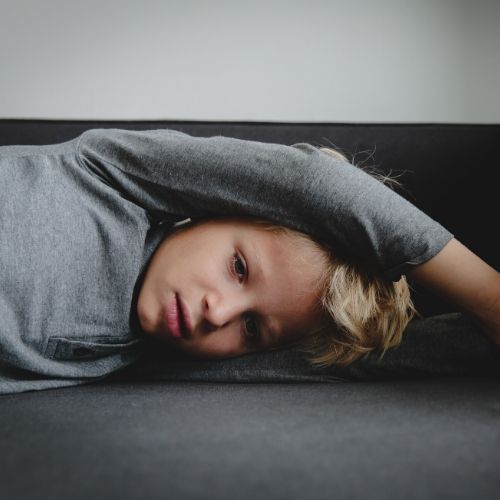
There are, on rare occasions, people whose bodies respond to lice as if they had a systemic infection, such as the flu. Their body will start producing bacteria-fighting white blood cells with the intention ward off the “sickness.” (This doesn’t work against lice, unfortunately). While their body is amping up to try to fight off lice, they will often have flu-like symptoms and just feel lousy.
In very rare occasions, severe head lice can cause anemia (due to lack of red blood cells). These people usually experience extreme fatigue.
Symptom #16 – Swollen Lymph Nodes
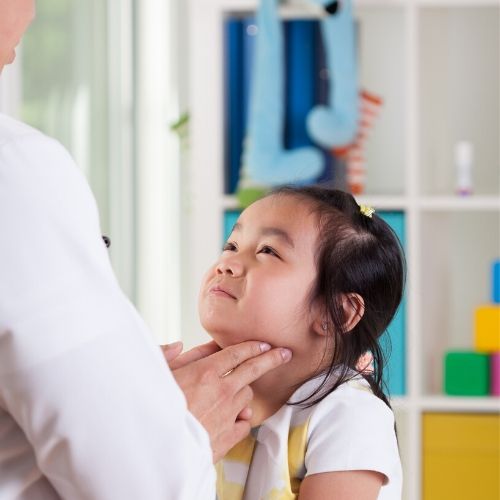
Swollen lymph nodes or glands is usually another result of someone’s body gearing up to try to fight off an infection such as a virus or bacteria. In rare occasions, some people with lice get swollen lymph nodes because their body is trying to fight the “sickness,” which is really a lice infestation.
Symptom #17 – Low-Grade Fever
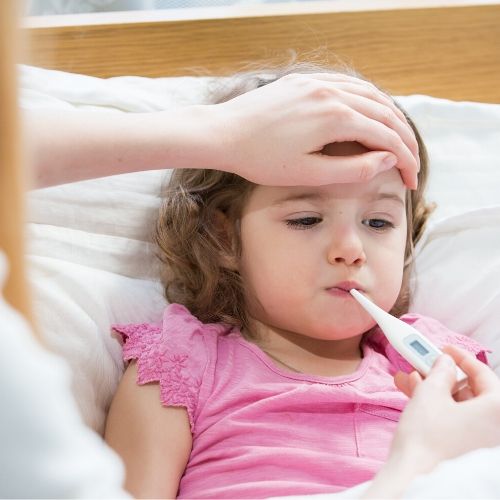
Along the same vein, if the body is preparing to attempt to fight off head lice, a person may have a low-grade fever. This is extremely rare and only happens to people whose bodies have extreme reactions to lice saliva.
How To Treat the Symptoms of Head Lice
Because lice symptoms are the results of an allergic reaction to lice saliva, the only way to get rid of the symptoms of head lice is to actually get rid of lice. There are hundreds of people that try to treat their itchy, lice-infested scalp with dandruff shampoo to no avail. As long as lice are on your head, you will have symptoms.
What If My Head Still Itches After Lice Treatment?
The first question is, what kind of treatment did you use? Lice are resistant to over-the-counter lice treatment products. They are MOST resistant to Permethrin and Pyrethrin products, so look on the back of the box you used and be sure that you didn't use one of those. If you did, then hope you get lucky. In the studies, Permethrin only kills about 25% of lice.
With that being said, it is common for some of the symptoms of head lice to continue after lice are gone. This is because head lice themselves are not the cause of the symptoms, but the lice saliva that enters into the scalp each time they feed. This is similar to other bug bites that itch significantly for several days after the literal bite. Lice symptoms decrease within a day or two of getting rid of lice and typically go away completely after a week.
But here's the key.... You have to get rid of lice!
If your symptoms do not go away, it is unfortunately likely that you did not completely eliminate lice. Super lice today are extremely resistant to most over-the-counter and prescription treatments. You can learn the most effective way to get rid of super lice here.
Why Is It So Hard to Get Rid of Lice?
Now that you know what you're looking for I want to talk briefly about your biggest worry (that your child actually has lice) and the question I get asked by parents around the world that have been battling lice….

Parents around the world are all asking me the same question…. "Why is it so much harder to get rid of lice now?"
Lice have become immune to everything that used to work in the past. Perhaps you remember your mom using a typical lice treatment or mayonnaise and that doing the trick. The new strain of head lice is no longer killed by those treatments, that’s why lice today are termed by people, “super lice,” because they are immune to those treatments.
I’ve cured thousands of people of lice in my lice center and let me tell you, I don't do it with over-the-counter lice treatments.

Most people struggle with lice because they focus all of their attention on killing lice bugs and not enough attention on GETTING RID OF LICE!
If you want to get rid of lice you have to address all 3 of the problems of lice:
- Lice Bugs
- Lice Eggs
- Getting Lice Back
The best way to get rid of lice is to tackle all 3 of these problems at the same time, which is what I teach in my step-by-step video system.
So, if you discover your child HAS lice, don't panic. Just head over to the video system. Follow along with the videos and you'll be done with lice by the end of the day.


Summing It Up...
Head lice have grown resistant to lice treatments that worked in the past, the new breed of lice is called super lice. Super lice and regular head lice have the same symptoms, the only difference is that super lice are very difficult to get rid of. The symptoms of lice can last for another week after lice is gone, because the symptoms are a reaction to the lice bites/lice saliva, which takes some time to resolve, but most people continue to have lice symptoms after treatment with over-the-counter products because lice are immune to those products.
You can treat lice symptoms, but the symptoms will never go away until you actually get rid of lice. The fastest and most effective way to do that is by getting rid of lice in one day, which is what you'll do with my step-by-step video system. Just follow along with the videos and you'll be done with lice in no time.
All the best,
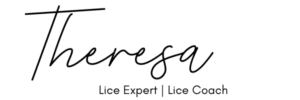

Theresa is a Registered Nurse and lice expert with years of experience curing children of lice. She owns a lice treatment center in the US which is where she perfected the Step-by-Step Video System proven to get rid of lice. She also works with government agencies and schools helping those with the worst head lice cases in America.
Her greatest passion is empowering parents by teaching parents online how to do a professional lice treatment on their child at home. She is the Lice Coach for the My Lice Advice Step-by-Step Video System.
Here’s a quick summary of the signs and symptoms of head lice.
17 Signs and Symptoms of Lice
- Bugs in the hair
- Lice eggs in the hair (often mistaken for dirt or increased dandruff)
- Itchy scalp, ears, or neck
- Rash or “lice bites” on the neck, behind the ears, and on the scalp
- Tickling or “something is in my hair” sensation
- Itching the scalp while sleeping
- Restless at night, sleepy during the day
- Increase in dandruff
- Tickling sensation on the whole ear
- Bumps on the scalp similar to acne
- Sores and scabs on the scalp
- Weeping clear fluid on the scalp
- Irritability
- Rash or red bumps on the shoulders or upper back
- Fatigue and feeling “awful”
- Swollen lymph nodes
- Low-grade fever
